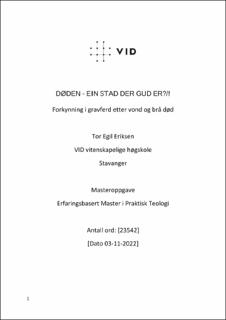| dc.contributor.author | Eriksen, Tor Egil | |
| dc.date.accessioned | 2023-06-01T06:14:42Z | |
| dc.date.available | 2023-06-01T06:14:42Z | |
| dc.date.issued | 2022 | |
| dc.identifier.uri | https://hdl.handle.net/11250/3069543 | |
| dc.description.abstract | Som prest har eg forretta i fleire gravferder etter det eg kallar «vond og brå død». Problemstillinga i denne oppgåva er innhaldet i gravferdspreikene i slike gravferder og korleis innhaldet vert brukt. Målet med oppgåva er at prestar ved refleksjon over eiga praksis kan verta tryggare på kva dei skal forkynne, og vere til støtte for dei pårørande med deira «phronesis», erfaringsbaserte visdom. I denne oppgåva har eg tatt ei kvalitativ analyse av seks gravferdspreiker haldne etter det dei involverte prestane sa var «vonde og brå» dødsfall. Prestane var i alder 30+ til 55, fire menn og to kvinner. Eg har nytta «Interpretative henomenological Analysis» (IPA) som metode når eg analyserte preikene. Eg har diskutert innhaldet i ramma av Knut E Løgstrup sin filosofiske tanke om den etiske fordringa at som eit menneske får eg i møte med ein annan person gitt noko av personens liv i mine armar. Dette opplever eg er ein tanke eg kjenner
igjen når eg har hatt slike gravferder. Funna synte at sjølv om preikene var heilt ulike, var der ein stor likskap når det gjaldt tema. Alle prestane gjekk inn i situasjonen ved dødsfallet og preika ope om den smerten det kunne gje. Dei gjekk så inn og stadfesta at alle menneske har stor verde i Gud sine auge, og at Gud var med dei gjennom liding og død. Det var ei nær samanheng mellom det læremessige og det
sjelesørgeriske innhaldet i preikene. Særleg vart Jesu død og oppstode viktig for ei sterk og mangslungen håpsforkynning i preikene. Håpet vart grunna i Guds kjærleik og/eller i Jesu død og oppstode. I fem av preikene er det ei klar forventning om ei oppstode. I fem av seks preiker kan det sjå ut som der er ei universell frelseforkynning. Samstundes opplever eg at preikene ikkje er like konkrete på korleis dei sørgande kan oppsøke eller oppleve Guds nærvær og trøst i tida etter gravferda. Oppgåva syner at «Den etiske fordringa» er ei meiningsfull ramme for å diskutere innhaldet og bruken av det ved slike dødsfall. Prestane ønsker å vere nær dei sørgande og bringe deira sorg fram for Gud og ein bodskap om håp i mørket frå Gud. Så er det mitt håp at andre vil forske vidare på tema som har med «vond og brå død» å gjera slik at vi som prestar kan forkynne med frimod at «døden er ein stad der Gud er! | en_US |
| dc.description.abstract | As a pastor in The Church of Norway, I have presided in a number of funerals after what I term «sudden and painful death». It is one of the most demanding situations I find myself in as a pastor. In this thesis I study the content of six different sermons held at such funerals and how this content was used. The aim is to inspire pastors to reflect over their own practise in similar situations, so that they become better prepared for these demanding situations. In this thesis, I have done a qualitative, hermeneutic analysis of six sermons held at funerals defined by the respective pastors as been in connection with “sudden and painful death”. I have used Interpretative Phenomenological Analysis (IPA) as described by Pietkiewicz
&Smith in an article. I have discussed the content in the framework of the Danish philosopher and theologian Knut Løgstrup idea of “The ethical demand”; that as a human I will carry something, small or large, of my neighbour’s life in my arms. My experience is that this term is meaningful in these situations of great pain and sorrow for the bereaved.Three of the sermons was at funerals after suicide, one an accident, and two where the pastors involved named them as fitting to my category. The pastors differed in age between 30 and 55 years, four males and two women. I found that although the sermons was very different, there was coherence when it came to themes and content, and the theological content and comforting aspects was closely connected. They went all directly into the death and the pain it had caused. They confirmed the value every person has in the eyes of God. Then they said something about how God was in the suffering, before they all tried to convey a hope about salvation and that God was near them in their sorrow. The hope was founded in the love of God and/or in the suffering, death
and resurrection of Jesus. The message about how God would be with the bereaved in the time after the funeral was not specific about how this could be experienced. It became clear that “the ethical demand” was a meaningful frame in which to discuss the content and its use, and it became clear that the pastors wanted to be near the bereaved and bring their grief before God and a message of hope from God. My hope is that this study will encourage pastors to reflect upon their own theology and how they will preach after “sudden and painful death” | en_US |
| dc.language.iso | nno | en_US |
| dc.rights | Attribution-NonCommercial-NoDerivatives 4.0 Internasjonal | * |
| dc.rights.uri | http://creativecommons.org/licenses/by-nc-nd/4.0/deed.no | * |
| dc.subject | teologi | en_US |
| dc.subject | Den norske kirke | en_US |
| dc.subject | døden | en_US |
| dc.subject | begravelser | en_US |
| dc.title | DØDEN - EIN STAD DER GUD ER? : Forkynning i gravferd etter vond og brå død | en_US |
| dc.type | Master thesis | en_US |
| dc.description.version | publishedVersion | en_US |
| dc.source.pagenumber | 65 | en_US |

